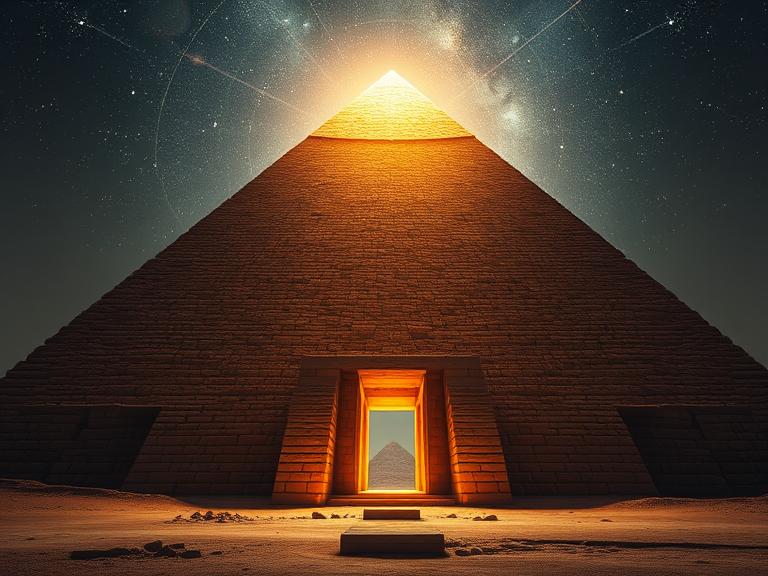
Sacred Geometry in Pyramids
Share
The Sacred Geometry Hidden in Ancient Pyramids
Published by Pyramason Team | Ancient Mysteries, Sacred Geometry
For millennia, the Great Pyramid of Giza has stood as humanity's most enigmatic architectural achievement. Beyond its impressive scale and precision construction lies a deeper mystery: the sophisticated mathematical principles embedded within its very structure. Today, we'll explore the sacred geometry hidden within ancient pyramids and show you how modern tools can help decode these ancient mathematical secrets.
The Golden Ratio: Nature's Perfect Proportion
The Great Pyramid's dimensions reveal an intimate relationship with the golden ratio (φ = 1.618...), a mathematical constant found throughout nature. When we examine the pyramid's slope angle of approximately 51.8 degrees, we discover that the ratio of the pyramid's height to half its base length equals the golden ratio.
This wasn't coincidental. Ancient Egyptian architects understood that this proportion created structures that felt naturally harmonious to the human eye—the same principle found in flower petals, nautilus shells, and galaxy spirals.
Pi Encoded in Stone
Perhaps even more remarkable is the pyramid's relationship to pi (π). The ratio of the pyramid's perimeter to its height equals 2π, meaning the ancient builders encoded the mathematical relationship between a circle's circumference and radius directly into the structure.
Consider this: the builders achieved this mathematical precision using tools and techniques we're still trying to fully understand. Each limestone block, some weighing over 15 tons, was positioned with tolerances measured in millimeters.
The Pyramid's Astronomical Alignments
Sacred geometry extends beyond mathematical ratios to celestial alignments. The Great Pyramid's sides align precisely with the cardinal directions, achieving an accuracy of 3/60th of a degree. The internal passages point toward specific stars:
- The King's Chamber shaft aligns with Orion (associated with Osiris)
- The Queen's Chamber shaft points toward Sirius (linked to Isis)
- The descending passage aligns with the north pole star position circa 2600 BCE
Modern Tools for Ancient Analysis
At Pyramason, we've developed interactive tools that allow you to explore these geometric relationships yourself. Our sacred geometry analysis features let you:
- Measure pyramid proportions and calculate golden ratio relationships
- Overlay geometric patterns onto archaeological site maps
- Compare dimensional ratios across different pyramid complexes
- Analyze astronomical alignments using historical star position data
Beyond Egypt: Global Pyramid Mysteries
The mathematical precision isn't limited to Egypt. Consider these examples:
Teotihuacan, Mexico: The Pyramid of the Sun incorporates the same base-to-height proportions as Giza, despite being built by a completely different civilization thousands of years later.
Angkor Wat, Cambodia: This temple complex uses sacred geometry principles in its layout, with proportions based on Hindu and Buddhist cosmological concepts.
Newgrange, Ireland: This Neolithic monument, older than Stonehenge and the Egyptian pyramids, demonstrates sophisticated understanding of solar alignments and geometric principles.
The Mathematical Language of the Ancients
What emerges from studying these structures is evidence of a shared mathematical language—one that transcended geographical boundaries and cultural differences. Whether through cultural exchange, independent discovery, or something more mysterious, ancient civilizations consistently applied these geometric principles in their most sacred architecture.
Exploring Sacred Geometry Today
You don't need to travel to Egypt to explore these mysteries. Using Pyramason's interactive mapping tools, you can:
- Analyze Proportions: Measure the geometric relationships in pyramid structures worldwide
- Compare Sites: Overlay different ancient sites to identify common geometric patterns
- Track Alignments: Explore how these monuments align with celestial bodies
- Join Research: Contribute to our growing database of geometric analysis
The Continuing Mystery
While we've decoded many aspects of pyramid geometry, questions remain. How did ancient builders achieve such precision? Was there a master template shared across cultures? What other mathematical secrets remain hidden in these ancient stones?
Every measurement we take, every pattern we identify, brings us closer to understanding the sophisticated minds that created these enduring monuments. The pyramids aren't just tombs or temples—they're mathematical textbooks written in stone, waiting for us to learn their lessons.
Ready to explore ancient mysteries yourself? Visit our interactive map to start analyzing sacred geometry in ancient sites worldwide. And when you shop our ancient mysteries collection, you're directly supporting the development of these free research tools.
What geometric patterns have you noticed in ancient architecture? Share your observations in the comments below and join our community of modern mystery seekers.
